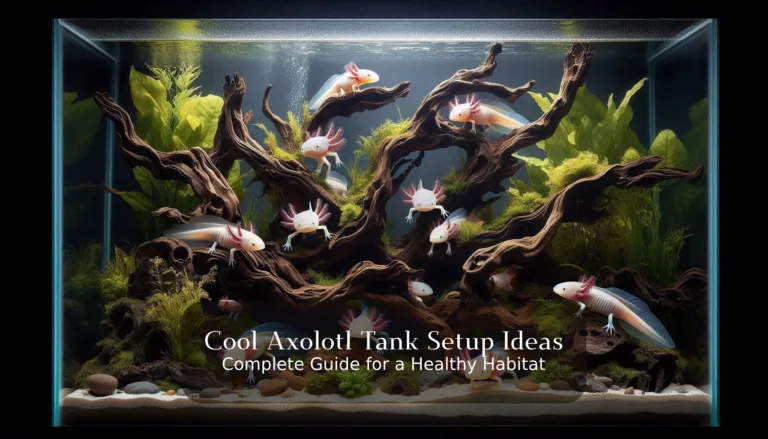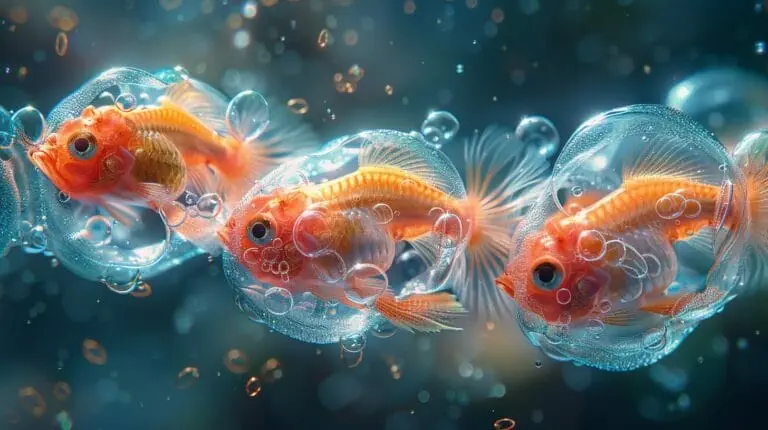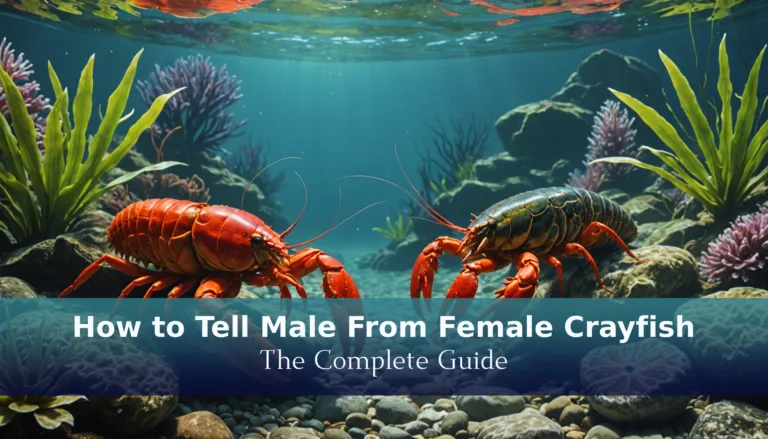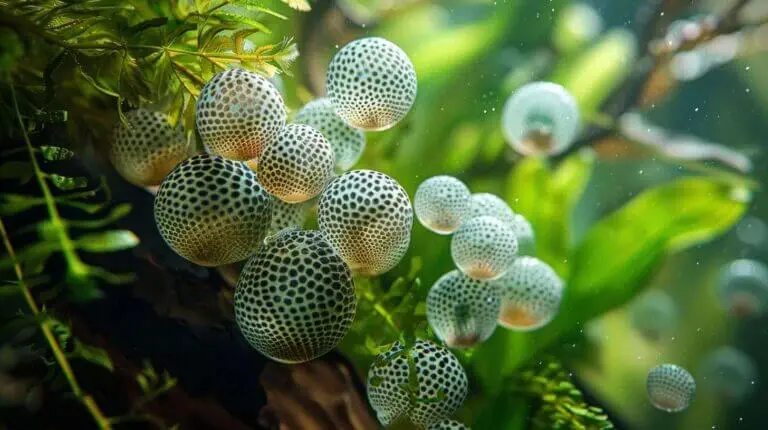Control Temperature and Humidity
You may think snail eggs need water to hatch. But clutches hold 50–200 eggs above water, and mystery snail eggs take 10–28 days at 75–80°F and 70–80% humidity to hatch. You will learn how to ensure your snails lay their eggs above water. This guide will show you how to keep eggs safe and help babies join your tank.
Use the Right Incubator
With ten years in a local fish store, I know snail species well. You will learn how I place clutches on a damp sponge in a simple incubator with a sponge filter. I spot when snails lay infertile eggs and stop mold fast. Keep reading.
Key Takeaways
- Clutches hold 50–200 eggs above the water. They hatch in 10–28 days at 75–80°F and 70–80% humidity.
- Incubate eggs in a sealed plastic box. Lay them on a damp towel or sponge. Add a small air pump or sponge filter for airflow.
- After hatching, move babies to a small tank. Keep water at 68–82°F, pH 7.0–8.0, hardness 6–18 dGH. Feed algae wafers and blanched veggies.
- For breeding, have at least one male and one female. Lower water by 3 inches so snails lay eggs above water. Transfer clutches to a humid incubator.
- Watch for problems: infertile clutches if no male is present and mold in low-airflow conditions. Keep heat, moisture, and ventilation stable.
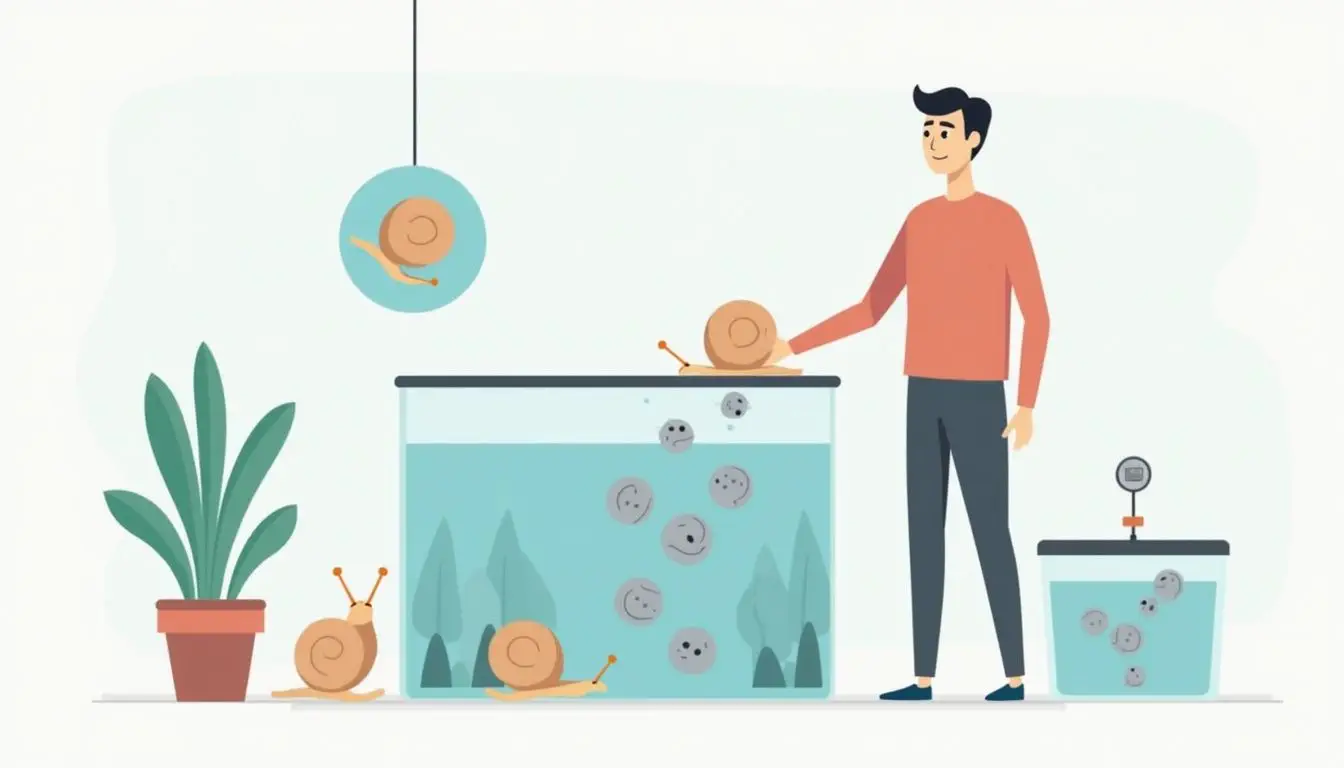
Finding mystery snail eggs in your aquarium can spark your excitement. It can also leave you with many questions about egg care. I’m an aquarium fan and I shoot underwater photos. I’ve seen clutches of Ampullariidae eggs in many community aquariums. I learned the best ways to help them grow.
This guide shows you how to care for eggs and hatch the tiny snails. You learn to set up egg incubation in a sealed box. Use a damp towel or a cloth inside a plastic container. Air must flow but not dry out the clutch. Keep the right heat and humidity. I add extra calcium to help shells grow. You can study shell hues at identifying snail shell colors.
Key Takeaways
- Mystery snail eggs come in clutches of 50–200 eggs above the waterline. They hatch in 10 days to 4 weeks based on temperature, humidity, and water quality.
- Set up a sealed incubator or plastic container with a tight lid. Place the clutch on a damp towel or sponge, and keep it moist. Add gentle air flow with a filter sponge.
- Move the hatchlings to a small tank or breeder box with a filter sponge. Offer soft algae wafers and blanched veggies. Gradually add them to your community aquarium after they reach the size of a pea.
- Ensure you have at least one male and one female mystery snail. Provide a dry surface above the waterline for egg laying, like the tank glass. Use a razor blade to lift clutches into your incubator.
- Watch out for infertile eggs if you lack a male or if snails lay eggs underwater. Mold can grow with high humidity or poor venting. Failures often come from wrong temperature or drying out.
Understanding Mystery Snail Eggs and the Hatching Process

Mystery snail eggs come in gelatinous, round clusters called a clutch of eggs. They stick to the upper lip of your tank, above the water line. I once watched my apple snail lay a clutch that held 50 to 200 eggs.
Female snails deposit a gel layer that hardens in a few days thanks to calcium carbonate. Tiny white specks may show if you look closely. Spots of green or gray on the clutch point to fungus or poor water parameters. A dry paper towel or too much heat can kill fertile eggs.
The hatching process spans from 10 days up to 4 weeks. It shifts with temperature, moisture levels, and overall health of the eggs. One time, I moved part of a clutch into a Tupperware incubator lined with a damp paper towel. That clutch hatched on day 10, while the rest in my aquarium took 14 days.
Eggs shift color from pink to magenta, then to brown. At last, they go semi-translucent as baby snails form inside. Condensation on the Tupperware lid can help keep the moisture even.
Hatchlings push through the shell and drop into the water. They look like tiny adults and begin to graze on biofilm. I like to feed mine thin slices of apple and algae wafers to boost growth.
To improve hatch rates, aim for a stable habitat. Keep water at 75°F to 80°F and pH around 7.5. Add extra calcium carbonate or a cuttlebone to keep shells strong. Give your clutch a shaded spot on aquarium plants or a snail ramp away from hungry fish. If you stop by your local aquarium co-op, you can pick up a good snail ramp to ease egg laying. Handle clutches on a damp paper towel with care so you don’t harm the eggs or upset moisture.
Match nature to hatch your eggs. In my years as an aquarist, I learned the key steps. I handled hundreds of mystery snail clutches. My tips help you set up the perfect hatch area.
- Keep your breeding tank at 75 to 80°F (24 to 27 °C). This range helps my clutch of mystery snail eggs develop well.
- Use a plastic box or food container as an egg incubator. It traps moist air around the clutch.
- Place your clutch on a damp sponge or paper towel. Moisture must touch the eggs but never flood them.
- Use only dechlorinated water to mist the incubator. Tap water chemicals can harm fertile mystery snail eggs.
- Add a small air pump or sponge filter near the incubator. Gently flowing bubbles boost oxygen levels.
- Stick to a normal day and night lighting schedule. Eggs need no special lights to grow.
- Position the incubator away from fish or shrimp. Predators can eat the eggs or baby mystery snails.
- Avoid sudden shifts in heat, moisture, or water levels. Stable settings make hatch success more likely.
- Check your clutch each day for mold or fungus. Wipe any spots gently with a clean, damp towel.
- Wait two to four weeks for eggs to hatch. Clutch size and tank temperature can speed or slow hatching.
Your snail babies need a calm home. I moved a clutch of over 100 eggs into a small incubator to save them.
- Use a small tank or breeder box for eggs and hatchlings. Fit a sponge filter for a soft flow.
- Keep water temp at 68–82°F. Aim for pH 7.0–8.0 and hardness 6–18 dGH.
- Offer soft foods like algae wafers and blanched spinach or zucchini.
- Chop food into tiny bits so tiny snails can eat easily.
- Remove leftover food after two hours to keep water clean.
- Change 10–20% of tank water each week to maintain good water quality. Maintain good water quality
- Add plants, driftwood, or small rocks for hiding spots and grazing surfaces.
- Leave snails in the box until they reach pea size. They hatch within 4–6 weeks.
- Move them by floating a small container in your community tank. Add main tank water in small steps over an hour.
- Watch snail babies for a few days to see they adapt and avoid fish or other invertebrates that might eat them.

Breeding mystery snails can be fun and rewarding for you.
You help a snail population grow with mystery snail eggs.
You can learn to harvest their egg clutches responsibly.
Follow these steps to breed mystery snails and care for the hatchlings.
- You need one male and one female mystery snail in your tank. If you cannot tell the sex, buy six or more to be sure you get both.
- Feed your snails extra food to help with mating. This also helps fertilize eggs.
- Lower the water line by about 3 inches to help them lay eggs above water.
- Provide a smooth hard surface above the water, like driftwood or the tank hood, for the egg clutch.
- Watch for a clutch on the tank wall each day. Be aware some snails lay unfertilized eggs; those will not hatch.
- Cut off the clutch with a sharp tool, being very gentle to protect the eggs.
- Place the clutch in a ventilated box as an egg incubator. Keep humidity high to help the eggs hatch.
- Mist the eggs daily with dechlorinated water. The eggs hatch in 1–4 weeks, based on water temperature and humidity.
- Move the hatchlings to a separate grow-out tank with food and hiding spots. Keep them away from adult snails so they do not become prey. Ensure they have calcium and good food for shell development.
- Sell or donate extra snails to avoid overpopulation. Never release mystery snails into the wild to protect local ecosystems.
Clutch Problems? How You Can Fix Them
Clutch Problems? How You Can Fix Them
You might see clutch issues when you care for mystery snail eggs.
Some fixes can help you avoid those problems.
Infertile clutches often show that eggs are laid under water or males are missing.
Keep two adult females per male in your tank so mystery snails lay their eggs above the waterline.
Mold can grow fast if humidity stays high and air flow is low.
Use a soft, wet cloth to wipe mold off the clutch and open vents around the eggs.
An egg incubator can help you keep air flow steady and stop more mold.
Eggs won’t hatch if incubation conditions are wrong.
You need a stable range of 65–82°F.
Use an aquarium heater and monitor water conditions.
Aim for 70–80% humidity by misting the clutch with dechlorinated water each day.
If a clutch dries out or drops in, move it to a bowl with damp paper towels right away.
Watch eggs daily for color change or tiny snail movement.
Most clutches take about 4 weeks to hatch.
Can Snails and Frogs Live Together in the Same Habitat?
?
You can keep some frogs and snails in one tank. I once added a burrowing frog to a tank with adult mystery snails. The snails can lay eggs above the water line on the glass. I saw the clutch change color when eggs are fertile. Soft plants gave the frog places to dig. The frog tunnels never crushed the eggs and let mystery snails reproduce safely. I fed snail food and frog pellets each day. Water stayed clean near the tank walls. Many aquarium hobbyists love this setup.
https://www.youtube.com/watch?v=16xGYA56DjY&pp=0gcJCdgAo7VqN5tD
Conclusion
Caring for mystery snail eggs can be a fun pet care task. I once saw a clutch of mystery snail eggs above water on my tank wall. I left the eggs in a small incubator with damp moss. I checked on them daily. I kept the humidity high with a light mist. The hatching occurs within two weeks in my setup. I watched tiny snails swim off. They looked like mini adults.
You can share this story with other aquarium hobbyists. You can guide them in mystery snail breeding. One mystery snail can lay hundreds of eggs. Some eggs may be infertile, keep an eye out. When you are ready to hatch the clutch, drop them gently back in the aquarium. You will see healthy baby snails thrive. That will prove your skill as an aquarist.
FAQs
1. What do mystery snail eggs look like?
Mystery snails lay eggs in a clutch above the water line. Whenever she lays her eggs, they form a clump above the tank. They look like little grapes or tiny worms. Most clutches are pink or magenta. A single cluster can span about 2 inches across.
2. How can you tell if mystery snail eggs are fertile?
Bright magenta or pink eggs often hold embryos. This means mystery snail eggs are fertile. You might spot tiny dark spots, the little snails forming inside. Eggs that are white or clear tend to be infertile. They contain no viable embryos or sperm.
3. How long does it take for mystery snail eggs to hatch?
Egg clutches usually take 2–3 weeks to hatch. Temperature and humidity affect how fast they hatch. You can help with hatching your mystery clutch by using a small incubator kept moist but not soaked. This tool can keep conditions stable. Avoid letting the eggs drop into the water.
4. How many babies do mystery snails have?
A single clutch (eggs) can hold 50 to 200 baby snails. Female mystery snails lay many clutches in their life. That means you can get hundreds of snails from laying eggs. This high output is a common thing about mystery snails among aquarium enthusiasts.
5. What do you do with mystery snail eggs in your aquarium?
You can leave the eggs in place if they sit above water. Make sure the clutch stays out of the tank water. Or you can remove the clutch with care. Place it in a container with high humidity and good air flow. This acts like a DIY incubator for egg care.
6. How do you care for newly hatched mystery snails?
After hatching, babies fall into the tank. You can feed them algae wafers or blanched greens. Provide a fine substrate and hiding spots. Monitor water quality closely when keeping mystery snails. Your help with hatch and care is key for their growth.
References
- https://www.theshrimpfarm.com/posts/breeding-mystery-snails/ (2024-03-18)
- https://forum.aquariumcoop.com/topic/26357-mystery-snail-eggs/ (2022-08-25)
- https://www.hepper.com/mystery-snail-eggs/
- https://www.aquariumcoop.com/blogs/aquarium/mystery-snail
- https://forum.aquariumcoop.com/topic/12371-breeding-mystery-snails/
- https://www.plantedtank.net/threads/mystery-snail-eggs.125996/ (2011-01-21)
- https://www.fishlore.com/aquariumfishforum/threads/help-with-mystery-snail-egg-clutch.272456/ (2017-03-25)
Conclusion
Eggs to Snails: Your Next Move
You place the egg clutch in your hatch chamber with a tiny bubbler to boost airflow. Your hatching success peaks when you hold 75–80°F and 70–80% humidity. Your eggs typically hatch in 10–28 days once conditions stay stable. You see mystery snails come out, babies look like mini versions of mom. You move them to a small tropical fish tank and feed wafers or blanched veggies.
FAQs
-
How do mystery snails come to lay their eggs above water?
Mystery snails come out of the water every night. They lay their eggs above water. The female will lay her eggs and then return to the water. They lay eggs and lay them in clusters next to the tank. This snail species digs a small nest before laying.
-
Where should I place the egg clutch for safe hatching?
Place the egg clutch above the water line in a humid spot. You can also move it to an incubator (egg). This keeps the clutch moist while trying to hatch. Check it daily for mold or dryness.
-
How long do mystery snail eggs take to hatch?
Mystery snail eggs take about two to four weeks to hatch. Eggs typically turn darker just before hatching. Keep them warm and humid. Mark the date you first saw the clutch.
-
What if my snails lay infertile eggs?
Some clutches contain no embryos. They lay infertile eggs that stay white and shrivel. Remove them to stop mystery snails from wasting energy. Toss them out to keep the nest clean.
-
What do baby mystery snails look like and how do I care for them?
Babies look like tiny adults with clear shells. They are a favorite among aquarium hobbyists. You can buy starter food at your local fish store. Although mystery babies need gentle care, they grow fast. Ensure your snails get enough calcium since mystery snails need it for strong shells.

